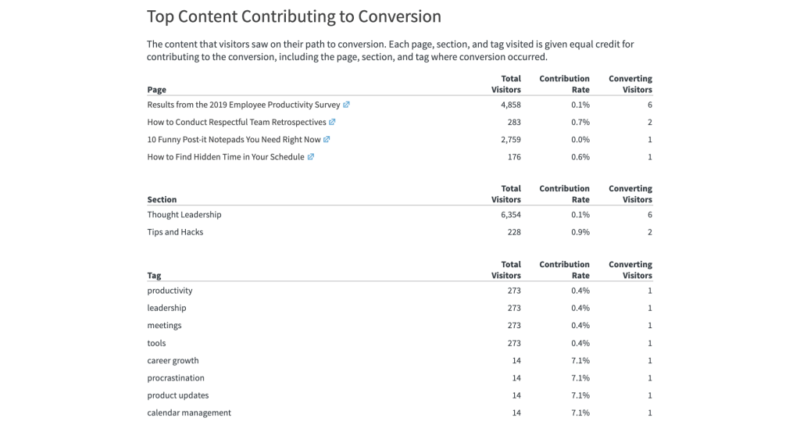Parse.ly looks to solve content marketing attribution challenges
A conversions report details which content converts the most users, which content contributes to the most conversions and the types of conversions.
Content marketing and analytics provider Parse.ly has rolled out the first generally-available release of Parse.ly Conversions. The solution seeks to help marketers address content attribution challenges of conversion reporting. It allows users to select different attribution models for assigning credit to content. The release also includes features such as labels that can be applied to categorize conversion actions.
“This release includes a conversions report that shows which content converts the most readers, which content contributes to the most conversions (even if it’s not converting directly on the content itself), and which types of conversions content drives best,” the company said in the announcement.
Why we should care
Determining how and which content is contributing to conversions is a challenge for many marketers. Some even have teams dedicated to stringing together data to understand the impact content has on their businesses. As marketing campaigns become more complex and spread across multiple channels — and create data siloes — it can become unclear as to what content or touchpoint actually drives conversions.
Parse.ly’s conversion report aims to provide clearer insight into how users interact with a brand’s content, from a high-level overview of all conversions to a detailed breakdown of its content performance and top referral sources.

Parse.ly also allows users to select one of three different marketing attribution models when building a conversion report: last touch, linear and pages before conversion. The flexibility to select based on a brand’s needs or campaign strategy will be beneficial to multichannel marketers and will benefit users with experimenting with different attribution models.

More on the news:
- Note that the conversions report is not comprehensive just reports data from the past week to provide a baseline.
- Parse.ly supports five standard conversion types and one custom type.
- The company indicated plans to analyze the five standard types as a benchmark for its customers to see how their brand performance compares to the rest of Parse.ly’s network.
Marketing attribution and predictive analytics: A snapshot
What it is. Marketing attribution and predictive analytics platforms are software that employ sophisticated statistical modeling and machine learning to evaluate the impact of each marketing touch a buyer encounters along a purchase journey across all channels, with the goal of helping marketers allocate future spending. Platforms with predictive analytics capabilities also use data, statistical algorithms and machine learning to predict future outcomes based on historical data and scenario building.
Why it’s hot today. Many marketers know roughly half their media spend is wasted, but few are aware of which half that is. And with tight budgets due to the economic uncertainty brought about by the COVID-19 pandemic, companies are seeking to rid themselves of waste.
Attribution challenges. Buyers are using more channels and devices in their purchase journeys than ever before. The lack of attributive modeling and analytics makes it even more difficult to help them along the way.
Marketers continuing to use traditional channels find this challenge magnified. The advent of digital privacy regulations has also led to the disappearance of third-party cookies, one of marketers’ most useful data sources.
Marketing attribution and predictive analytics platforms can help marketers tackle these challenges. They give professionals more information about their buyers and help them get a better handle on the issue of budget waste.
Read Next: What do marketing attribution and predictive analytics tools do?
Contributing authors are invited to create content for MarTech and are chosen for their expertise and contribution to the search community. Our contributors work under the oversight of the editorial staff and contributions are checked for quality and relevance to our readers. MarTech is owned by Semrush. Contributor was not asked to make any direct or indirect mentions of Semrush. The opinions they express are their own.
Related stories
New on MarTech